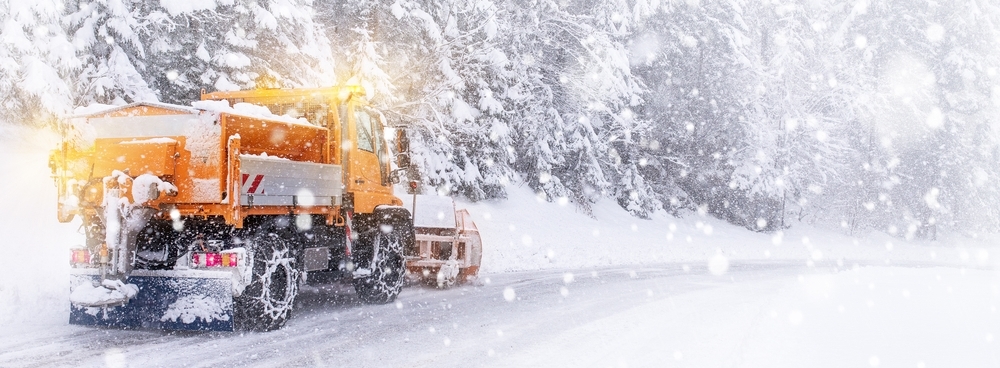 Driving any distance during bad winter weather can be stressful. Hidden hazards can lurk under fallen leaves, in puddles, and over bridges. Ice can quickly form when our chilly fall temperatures drop into the 30s, making the roads treacherous. This is where road salt comes to the rescue… but are there hidden issues we must be aware of? The short answer is yes. While road salt can help reduce the dangers of winter driving, motorists must practice winter auto maintenance to help reduce the chance of vehicle rust and corrosion.
Driving any distance during bad winter weather can be stressful. Hidden hazards can lurk under fallen leaves, in puddles, and over bridges. Ice can quickly form when our chilly fall temperatures drop into the 30s, making the roads treacherous. This is where road salt comes to the rescue… but are there hidden issues we must be aware of? The short answer is yes. While road salt can help reduce the dangers of winter driving, motorists must practice winter auto maintenance to help reduce the chance of vehicle rust and corrosion.
Winter Driving Can Be Dangerous
Winter weather can cause extremely dangerous road conditions. According to NHTSA, in 2022, almost 500 fatal traffic collisions and over 32,000 injury-causing crashes occurred in the U.S. during snow, icy, or sleeting conditions. Black ice is considered one of the sneakiest hazards. It’s almost completely clear without air bubbles or swirls to cloud the appearance of the dark roadway beneath it. Motorists often mistake black ice for simple road wetness and not the deadly slippery ice that it is. To help combat these winter hazards on well-traveled roadways, communities use road salt.
What Is Road Salt?
Road salt is a chemical compound that melts roadway snow and ice by altering the temperature at which it freezes. Road Salts can also prevent new ice from forming and improve traction. Salt (sodium chloride) is popular because it is inexpensive and widely available. In areas prone to freezing winter weather, the transportation infrastructure must respond quickly to snow and ice on roads and highways. Ice prevention and removal is a mandatory safety service for most communities.
De-Icing Formulas
There are plenty of concerns about the widespread use of road salt. Too much salt has negative environmental factors, including aquatic life toxicity, plant life damage, and fertilization issues. Environmentalists are researching and developing other methods of de-icing that are less hazardous to nature. There are currently numerous different de-icing agents in use across the United States. They vary in temperature effectiveness, toxicity, and other environmental factors.
The following list is from AGI (American Geosciences Institute):
- Calcium chloride – is commonly used; it works above -20°F. Made by reacting sodium chloride with calcium carbonate collected from the central and eastern U.S.
- Magnesium chloride – works above 5°F. Domestic production capacity was 300,000 metric tons in 2015; 99% of domestic production is extracted as brine from Utah’s Great Salt Lake.
- Potassium chloride – works above 20°F. About 460,000 tons were produced domestically in 2015, largely refined from potassium ores mined in New Mexico and Utah.
- Sodium chloride – is used as crushed rock salt, which is inexpensive, abundant, and easy to mine, store, distribute, and apply. It cannot effectively melt ice below 10°F (-12.2°C). Some areas use salt brines, but the vast majority still use rock salt.
- Acetates – Potassium acetate works above -15°F. Calcium-magnesium acetate works above 20°F. Acetates do not corrode metal but do damage concrete. They are biodegradable but can affect oxygen levels in lakes.
- Sand – does not melt ice but provides traction and helps break up ice mechanically. Not all states use sand, but roughly nine million tons of sand were used for snow and ice control on U.S. roadways in 2015.
Does Road Salt Damage My Car?
Regardless of the de-icing formula used, none of them are good for your car. In general, the various road salts used to melt snow and ice on roadways are corrosive to metal components. They can also cause pitting and discoloration to paint, chrome, and plastic parts.
Top Automotive Issues From Road Salts
Vehicle Rust
Most de-icers are hygroscopic, which means they attract and retain moisture. This is why the metal parts in your car’s undercarriage often rust from exposure to road salt. Vehicle rust occurs when iron (including steel) and moist air meet. The road salt mixes with oxygen and water molecules in the air, causing a chemical reaction with the metal to form hydrated oxide (rust).
Paint Damage
Your vehicle’s paint can also suffer harm from prolonged exposure to road salts. Since road salts are naturally corrosive, they can strip away the protective coating of your car’s paint, leading to discoloration, reduced shine, and flaking. Salt crystals are also sharp, which can cause surface scratches to the clear coat, allowing more damage to occur if left untreated.
Corrosion
Your vehicle’s tires are in constant contact with the road, but luckily, road salt does not affect the rubber. Your vehicle’s wheels, on the other hand, can experience corrosion from road salt exposure. Chrome wheels need extra care to prevent damage during the winter months. The chrome finish can be scratched and pitted, which allows rust to form under the shiny surface. This damage is not only unsightly but also compromises the safety of the wheel itself.
Minimize Vehicle Exposure To Road Salt
If you need to drive in the winter, there is no real way to avoid road salt. But, there are ways to minimize road salt’s effect on your vehicle.
Frequent Car Washes
Since avoiding road salt entirely during the winter is unrealistic, do your best to wash it away. Drive-through car washes with an undercarriage cleaning feature can help remove road salt deposits from those vulnerable components before they rust. Run your car through the wash during the warmest part of the day (and use the blow-dry feature) so it can dry completely. If you do a lot of driving during the winter, wash your car at least twice a month. Remember to apply a coat of wax to seal and protect your paint job from the harsh winter weather.
Timing Is Everything
Try to drive during the warmest part of the day when there is a lower chance of snow and ice build-up on the roads. Avoid driving through puddles of meltwater on the side of the road whenever possible. These puddles often contain high levels of melted road salt.
Routine Auto Maintenance
Sticking to your routine maintenance schedule during winter is a great way to spot trouble areas early. Many auto services require raising your on the rack to access components in the undercarriage. Your service technician can easily see if your springs, shocks, exhaust, or muffler require washing, oiling, or sealing for rust-proofing.
Undercarriage Sealant
There are many aftermarket undercarriage sealants available. It is best to apply them long before freezing temperatures set in. Ensure your car and undercarriage are completely clean and free of all de-icing agents. You do not want to accidentally seal any road salts to the components of your undercarriage.
Winter Auto Maintenance: Kirkland, WA
Winter auto maintenance at Fisher’s Auto Service in Kirkland, WA, often includes an oil change and tire rotation. Our technicians can also inspect your vehicle’s brakes, fluids, lights, wiper blades, tires, air filters, and car battery. By monitoring all these areas of your car, we can ensure no hidden problems could cause a part or system failure. Routine auto maintenance during the winter can extend the life of your vehicle and improve winter driving safety. A detailed inspection can also help avoid rust and corrosion of vulnerable parts due to road salt.
Schedule A Road Salt Damage Inspection
Call us at (425) 441-3626 or visit our website to schedule your winter auto maintenance service.

